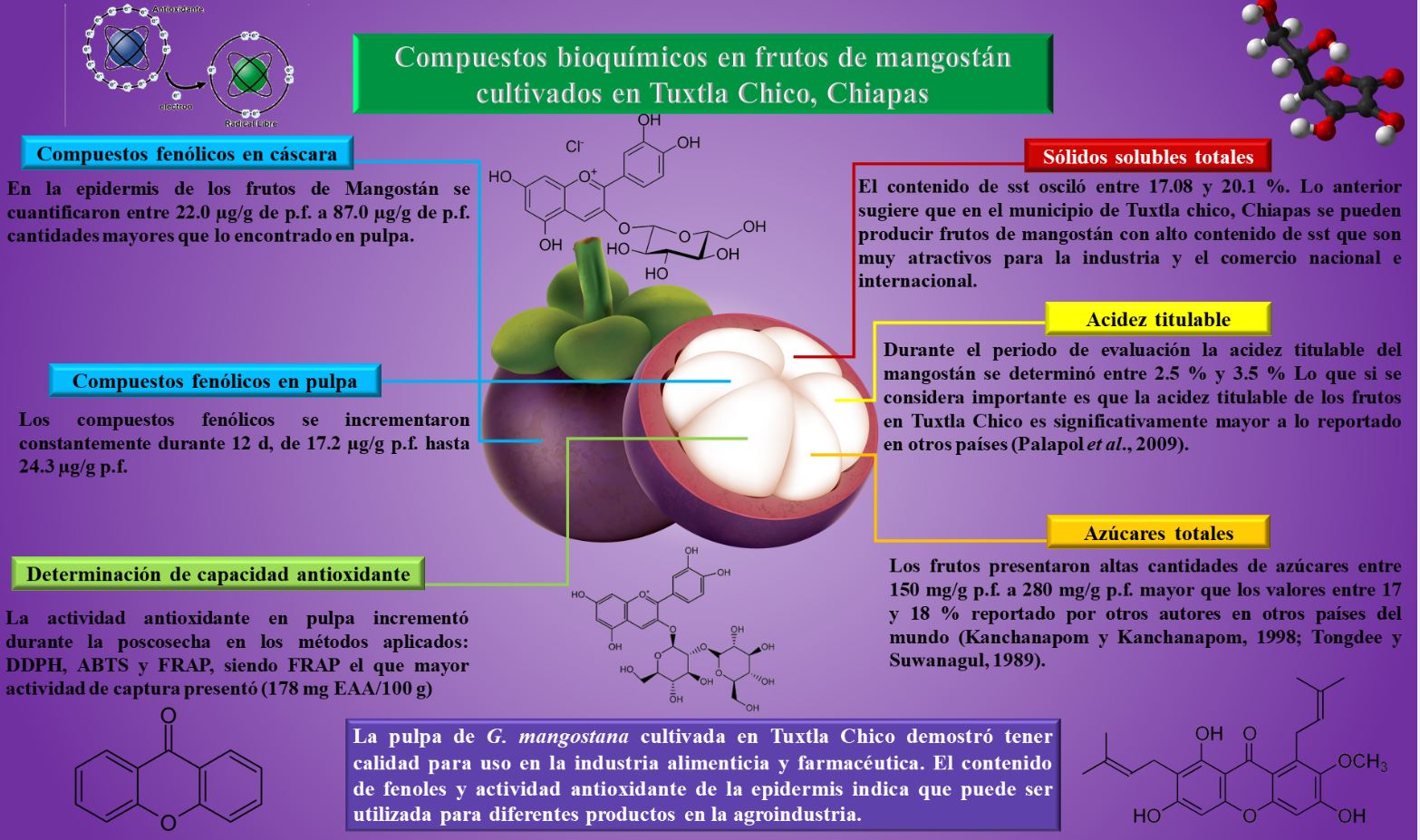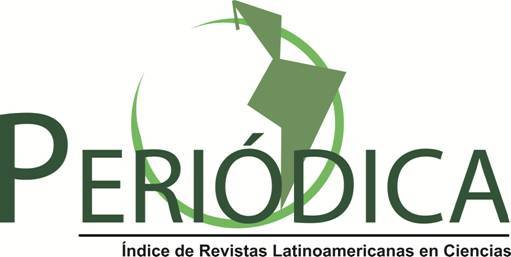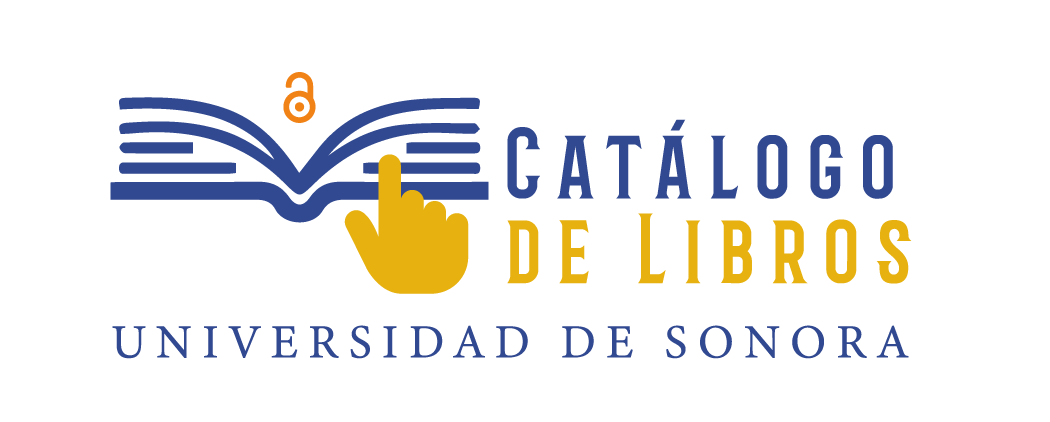Chemical characterization of mangosteen fruits Garcinia mangostana L. cultivated in Tuxtla Chico, Chiapas, Mexico
DOI:
https://doi.org/10.18633/biotecnia.v26.2410Keywords:
Garcinia mangostana, Characterization, ChemicalAbstract
Garcinia mangostana fruit contains biomolecules with great antioxidant capacity; causing interest in the pharmaceutical industry. The present study describes biochemical characteristics of the mangosteen fruit cultivated in Tuxtla Chico, Chiapas. The fruits were ripened at 23° C, 70% R.H., and were analyzed at 0, 3, 6, 9 and 12 d after harvest. The fruits presented high amounts of sugars (150 mg/g w.f. to 280 mg/g w.f.) of which trees 26 and 219 presented the highest peak on day 12. Total solubles reached maximum values on day 0 (20.1 °Brix) in tree 26, tree 94 registered the highest average (19.5 °Brix). Phenolic compounds were quantified at 17.76 µg/g and 49.21 µg/g in pulp and peel, respectively; corroborating that the peel, which is discarded, has potential molecules for exploitation. The antioxidant activity in pulp increased during post-harvest in the applied methods: DDPH, ABTS and FRAP, being FRAP the one that presented the highest capture activity (178 mg EAA/100 g), where tree 284 registered the highest average (111.08 mg EAA/100 g), proving that G. mangostana fruits grown in Tuxtla Chico, Chiapas, show antioxidant potential.
Downloads
References
Andayani, R., Armin, F. y Mardhiyah, A. 2020. Determination of the total phenolics and antioxidant activity in the rind extracts of Garcinia mangostana L. Garcinia cowa Roxb., and Garcinia atroviridis Griff. EX T. Anders. Asian Journal of Pharmaceutical and Clinical Research. 13: 149–152. https://doi.org/10.22159/ajpcr.2020.v13i8.36525
A.O.A.C. 1990. Oficial method of analysis. 16th ed. N. Hoorwitz, P. Chialo, & H. Reynold, (Eds.). Association of Official Analiytical Chemistry. Washington, D.C.
Benzie, I.F. y Strain, J.J. 1996. The ferric reducing ability of plasma (FRAP) a measure of “antioxidant power”: the FRAP assay. Anal. Biochem. 239(1): 70–76.
Brand, W. W., Cuvelier, M. y Berset C. 1995. Use of a Free Radical Method to Evaluate Antioxidant activity. Lebensm-Wiss Technology Food Science and Technology. 28(1): 25–30.
Castro, M.F.P.P.M., Anjos, V.D. de A., Rezende, A.C.B., Benato, E.A. y Valentini, S.R. de T. 2012. Postharvest technologies for mangosteen (Garcinia mangostana L.) conservation. Food Science and Technology. 32(4): 668–672. https://doi.org/10.1590/S0101-20612012005000103
Chew, Y.-L. y Lim, Y.-Y. 2018. Evaluation and Comparison of Antioxidant Activity of Leaves, Pericarps and Pulps of Three Garcinia Species in Malaysia Yik-Ling Chew, and Yau-Yan Lim. Free Radicals and Antioxidants. 8(2): 130–134. https://doi.org/10.5530/fra.2018.2.19
Daza, R.L.D., Murillo, P.E., Méndez, A.J., Murillo, A.W., Moyano, D.D. y Osorio, N. 2012. Potencial antioxidante de la cáscara del mangostino. Revista Vitae. 19(1): S355–S356.
Díaz, A.M. y Picón, R.L. 2007. Influencia de los factores climáticos en la fenología del mangostán (Garcinia mangostana L.) en la zona centro del estado de Veracruz, México. En Memoria del II simposio Internacional de Fruticultura tropical y subtropical. p. 98.
Díaz, F.V.H. y Díaz, H.B.G. 2011. El mangostán (Garcinia mangostana L.): Una alternativa para la reconversión productiva en la región tropical húmeda de México. En Tecnologías de producción para el trópico. 65 aniversario del Campo Experimental Rosario Izapa. INIFAP. Campo Experimental Rosario Izapa, Libro Técnico No 7. G.G. López, D.J. Iracheta, y A.C.H. Avendaño (ed.), pp. 74–78. INIFAP. Tuxtla Chico, Chiapas, México.
Díaz, F.V.H., Díaz, H.B.G., Ruíz, C.P.A., Mariles, F.V., Cano, G.M.A. y Gálvez, M.L.A. 2011. El mangostán Garcinia mangostana L. Libro Técnico No 8. INIFAP. Tuxtla Chico, Chiapas, México.
Díaz Fuentes, V. H., Ruíz-Cruz, P.A., Nájera-Domínguez, W., Iracheta-Donjuán, L. y Gálvez-Marroquín, L.A. 2019. Comportamiento productivo inicial del mangostán (Garcinia mangostana L.) en el Soconusco, Chiapas, México. Agro Productividad. 12(3): 17–22. https://doi.org/10.32854/agrop.v0i0.1321
FAO. 2022. Major Tropical Fruits Market Review 2021. https://openknowledge.fao.org. Fecha de consulta: 10 de mayo de 2024.
Gondokesumo, M.E., Pardjianto, B., Sumitro, S.B., Widowati, W. y Handono, K. 2019. Xanthones Analysis and Antioxidant Activity Analysis (Applying ESR) of Six Different Maturity Levels of Mangosteen Rind Extract (Garcinia mangostana Linn.). Pharmacognosy Journal. 11(2): 369–373. https://doi.org/10.5530/pj.2019.11.56
INEGI. 2010. Compendio de información geográfica municipal 2010 Tuxtla Chico Chiapas. https://www.inegi.org.mx/contenidos/app/mexicocifras/datos_geograficos/07/07102.pdf. Fecha de consulta: 07 de abril de 2024.
John, O.D., Mouatt, P., Panchal, S.K. y Brown, L. 2021. Rind from Purple Mangosteen (Garcinia mangostana) Attenuates Diet-Induced Physiological and Metabolic Changes in Obese Rats. Nutrients. 13(2): 319. https://doi.org/10.3390/nu13020319
Kanchanapom, K. y Kanchanapom, M. 1998. Mangosteen. En Tropical and Subtropical Fruits. P.E. Shaw, H.T. Chan, y S. Nagi (ed.), pp. 191–216. AgScience Inc.
Ketsa, S. y Paull, R.E. 2011. Mangosteen (Garcinia mangostana L.). En Postharvest Biology and Technology of Tropical and Subtropical Fruits. E. M. Yahia (ed.), pp. 1–30. Woodhead Publishing.
Larasati, F., Batubara, I. y Lestari, Y. 2020. The presence of endophytic actinobacteria in mangosteen peel (Garcinia mangostana) and its antioxidant activity. Biodiversitas Journal of Biological Diversity. 21(4): 1488–1497. https://doi.org/10.13057/biodiv/d210429
Manurakchinakorn, S., Issalakraisila, M. y Nuymak, P. 2008. Physiological and Quality Attributes of Mangosteens (Garcinia mangostana L.) as Affected by Modified Atmosphere Packing. Acta Horticulturae. 768: 239–246. https://doi.org/10.17660/ActaHortic.2008.768.29
Mosquera, M.O.M., Obando, C.M.A. y Ortega, C.N. 2020. Chemistry Characterization and antioxidant activity of mangosteen (Garcinia mangostana L., Clusiaceae) cultivated in Colombia. Revista Boletín Latinoamericano y del caribe de plantas medicinales y aromáticas. 19(2): 167–178.
Mulyono, D., Irawati, Y. y Syah, M.J.A. 2021. Identification morphological variability of six mangosteen (Garcinia mangostana L.) As a conservation strategy for local varieties. IOP Conference Series: Earth and Environmental Science. 739(1): 012076. https://doi.org/10.1088/1755-1315/739/1/012076
Mustafa, M.A., Ali, A., Seymour, G. y Tucker, G. 2018. Delayed pericarp hardening of cold stored mangosteen (Garcinia mangostana L.) upon pre-treatment with the stress hormones methyl jasmonate and salicylic acid. Scientia Horticulturae. 230: 107–116. https://doi.org/10.1016/j.scienta.2017.11.017
Muzykiewicz, A., Zielonka-Brzezicka, J., Siemak, J. y Klimowicz, A. 2020. Antioxidant activity and polyphenol content in extracts from various parts of fresh and frozen mangosteen [pdf]. Acta Scientiarum Polonorum Technologia Alimentaria. 19(3): 261–270. https://doi.org/10.17306/J.AFS.2020.0788
Nardini, M. y Garaguso, I. 2020. Characterization of bioactive compounds and antioxidant activity of fruit beers. Food Chemistry. 305: 125437. https://doi.org/10.1016/j.foodchem.2019.125437
Nauman, M.C. y Johnson, J.J. 2022. The purple mangosteen (Garcinia mangostana): Defining the anticancer potential of selected xanthones. Pharmacological Research. 175: 106032. https://doi.org/10.1016/j.phrs.2021.106032
Nawawi, N., Ijod, G., Abas, F., Ramli, N., Mohd Adzahan, N. y Mohamad Azman, E. 2023. Influence of Different Drying Methods on Anthocyanins Composition and Antioxidant Activities of Mangosteen (Garcinia mangostana L.) Pericarps and LC-MS Analysis of the Active Extract. Foods. 12(12): 2351. https://doi.org/10.3390/foods12122351
Palapol, Y., Ketsa, S., Stevenson, D., Cooney, J.M., Allan, A.C. y Ferguson, I.B. 2009. Colour development and quality of mangosteen (Garcinia mangostana L.) fruit during ripening and after harvest. Postharvest Biology and Technology. 51(3): 349–353. https://doi.org/10.1016/j.postharvbio.2008.08.003
R. Parijadi, A.A., Ridwani, S., Dwivany, F.M., Putri, S.P. y Fukusaki, E. 2019. A metabolomics-based approach for the evaluation of off-tree ripening conditions and different postharvest treatments in mangosteen (Garcinia mangostana). Metabolomics. 15(5): 73. https://doi.org/10.1007/s11306-019-1526-1
Re, R.P.N., Proteggente, A., Pannala, A., Yang, A. y Rice-Evans, C. 1999. Antioxidant activity applying an improved ABTS radical action decolonization assay. Free Radic Biology and Medicine. 22: 1231–1337.
Rizaldy, D., Hartati, R., Nadhifa, T. y Fidrianny, I. 2022. Chemical Compounds and Pharmacological Activities of Mangosteen (Garcinia mangostana L.) – Updated Review. Biointerface Research in Applied Chemistry. 12(2): 2503–2516. https://doi.org/10.33263/BRIAC122.25032516
Rohman, A., Rafi, M., Alam, G., Muchtaridi, M. y Windarsih, A. 2019. Chemical composition and antioxidant studies of underutilized part of mangosteen (Garcinia mangostana L.) fruit. Journal of Applied Pharmaceutical Science. 9(8): 47–52. https://doi.org/10.7324/JAPS.2019.90807
Rueda, S.A., Pérez, D.J.F. y Ireta, M.J. 2014. El cultivo del mangostán (Garcinia mangostana) como nueva alternativa de producción en el estado de Jalisco.
Sari, N., Katanasaka, Y., Sugiyama, Y., Miyazaki, Y., Sunagawa, Y., Funamoto, M., Shimizu, K., Shimizu, S., Hasegawa, K. y Morimoto, T. 2021. Alpha Mangostin Derived from Garcinia magostana Linn Ameliorates Cardiomyocyte Hypertrophy and Fibroblast Phenotypes in Vitro. Biological and Pharmaceutical Bulletin. 44(10): 1465–1472. https://doi.org/10.1248/bpb.b21-00294
Singleton, V.L., Orthofer, R. y Lamuela R.R.M. 1999. Analysis of total phenols and other oxidation substrates and antioxidants by means of Folin-Ciocalteu reagent. Revista Methods in Enzymology, 299: 152–178.
Sumiasih, I.H., Poerwanto, R. y Efendi, D. 2019. Study of Several Stages of Maturity and Storage Temperature on Color Changes and Shelf Life of Mangosteen (Garcinia mangostana L.). International Journal of Applied Biology. 3(1): 45–54. https://doi.org/10.20956/ijab.v3i1.5967
Suttirak, W. y Manurakchinakorn, S. 2014. In vitro antioxidant properties of mangosteen peel extract. Journal of Food Science and Technology. 51(12): 3546–3558. https://doi.org/10.1007/s13197-012-0887-5
Tac-an, A.M.I., Lacap, A.T., Bayogan, E.R.V. y Lubaton, C.D.S. 2021. Postharvest Quality of Two Mangosteen (Garcinia mangostana L.) Fruit Maturities Held in Ambient and CoolBot-equipped Cold Storage. Journal of Science, Engineering and Technology (JSET). 9(1): 48–60. https://doi.org/10.61569/n49qq233
Tiang, N., Ahad, M.A., Murugaiyah, V. y Hassan, Z. 2020. Xanthone-enriched fraction of Garcinia mangostana and α-mangostin improve the spatial learning and memory of chronic cerebral hypoperfusion rats. Journal of Pharmacy and Pharmacology. 72(11): 1629–1644. https://doi.org/10.1111/jphp.13345
Tongdee, S. C. y Suwanagul, A. 1989. Postharvest mechanical damage in mangosteens. Revista ASEAN Food. 4: 151–155.
Witham, F.H., Blaydes, D.F. y Devlin, R.M. 1971. Experiments in Plant Physiology. Van Nostrand Reinhold Company. New York, U.S.A.
Wongs-Aree, C. y Noichinda, S. 2022. Postharvest quality properties of potential tropical fruits related to their unique structural characters. En Postharvest Handling Fourth. J.W. Florkowski, H.N. Banks, L.R. Shewfelt, y E.S. Prussia (ed.). Academic Press. https://doi.org/10.1016/B978-0-12-822845-6.00009-9
Yani, F., Belllastasie, R., & Fauziah, F. 2021. Antidiabetic Potential of Garcinia mangostana Extract and α-Mangostin Compounds from Mangosteen (Garcinia mangostana Linn.). EAS Journal of Pharmacy and Pharmacology. 3(5): 95–105.

Downloads
Published
How to Cite
Issue
Section
License
Copyright (c) 2023

This work is licensed under a Creative Commons Attribution-NonCommercial-ShareAlike 4.0 International License.
The journal Biotecnia is licensed under the Attribution-NonCommercial-ShareAlike 4.0 International (CC BY-NC-SA 4.0) license.




_(1)_(1).png)






_(2).jpg)





